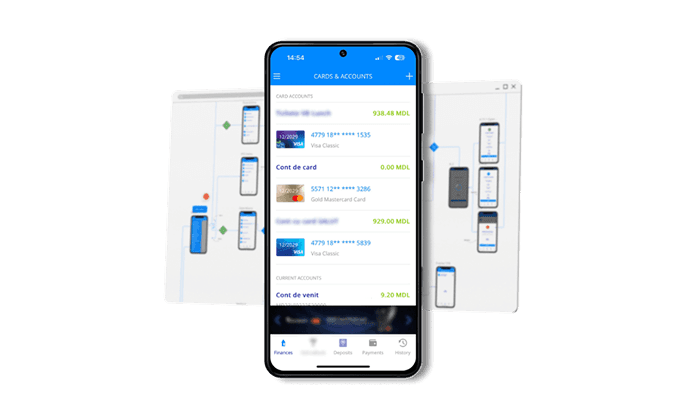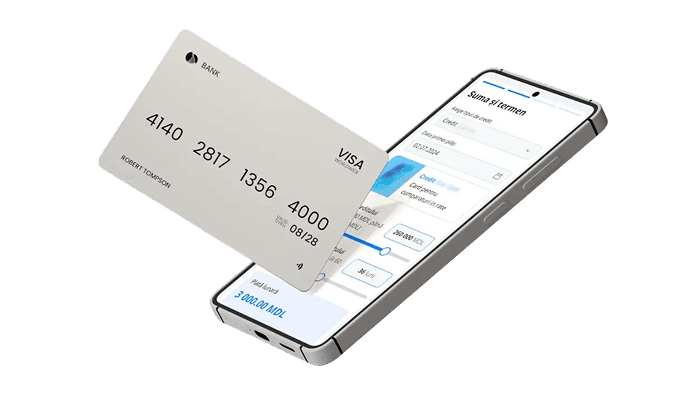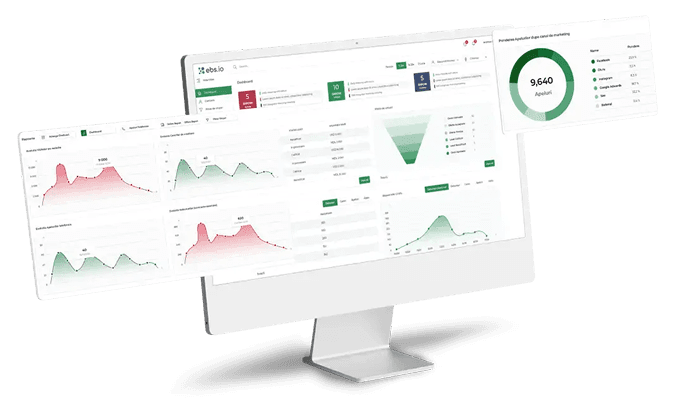Financial Services
Digital tools that power finance, backed by analysis and scalable system design
Our Solutions for Your Financial Sector
Banking
- Open Banking Architecture (RESTful, PSD2)
- Legacy Banking System Modernization
- Integrated Payments (IPS, eFactura, NFC)
- API Gateway (third-party access & control)
- Compliance & Reporting Dashboards
- KYC/AML Compliance Suite (Identity & Risk)
Microfinance
- Loan Management & CRM
- Credit Scoring Engine (Rule-Based & AI)
- Client Risk Screening (Blacklist & PEP)
- Recurring Billing & Automatic Debit
- Multi-Channel Notifications (SMS, Mail, Push)
- Account Integration & Real-Time Sync
Trading
- Real-Time Liquidity Integration (FX, Crypto)
- AI-Powered Trading Algorithms
- PBX & Voice Integration
- Live Market Data APIs (FX, Crypto, Stock)
- Fiat & Crypto Payment Integration
- Regulatory Compliance (SEC, GDPR, FINRA)
0+
successful fintech projects
0+
industry-focused experts
0+
years in fintech innovation
0.0*
client rating on Clutch
Essential Technologies Powering Digital Finance
KYC + AML Automation (CRM-integrated)
As more customers sign up, financial companies often hire extra people to check documents and follow compliance rules. But when profits go down, this approach becomes too expensive. Teams end up bringing in staff just to deal with piles of ID checks and warning alerts, which slows things down and adds to costs.
Challenge
- Customers send blurry ID photos through email or chat, and systems fail to extract valid data
- Manual checks take 1–2 days, delaying onboarding and frustrating users
- Inconsistent or delayed screening increases exposure to fraud and compliance risk
- Users drop off due to complex or unclear onboarding steps
- Compliance teams are overloaded, and adding more people to the team drives up cost
Solution
- Automated ID verification via OCR
- Biometric facial recognition
- Real-time AML screening (PEPs, sanctions)
- Embedded, low-friction UX/UI onboarding flow
- REST API-based system integration (connects KYC/AML results directly to CRM/back-office)
Open Banking API Integration
Even though PSD2 is active, many banks still check income using old methods like PDF uploads. This slows things down, costs more, and creates compliance risks. With Open Banking now widely adopted, using secure APIs to access live bank data—with customer consent—is becoming essential for faster decisions, lower risk, and modern, compliant operations.
Challenge
- Customers often upload outdated or incomplete PDF statements, which slows verification.
- Back-office teams spend 1–2 days reviewing documents, slowing down credit decisions
- Altered or missing data in PDFs makes fraud harder to detect and increases compliance risk.
- High application volumes require more manual effort, which inflates processing costs
- Compliance with PSD2 and GDPR becomes difficult with no automated consent and data tracking.
Solution
- Open Banking API (PSD2, ISO 20022)
- AIS Integration (account data access)
- Read-only connection (prevents tampering)
- Automated income and risk analysis
- Consent & audit logs (GDPR, PSD2)
Secure Access & Transaction
Under PSD2, financial applications must implement Strong Customer Authentication (SCA) to protect access, payments, and user profile changes. Without SCA, platforms can’t legally interact with Open Banking APIs or licensed payment service providers. Beyond compliance, the lack of a second factor increases fraud risk and weakens user trust.
Challenge
- Password-only logins don't comply with PSD2 SCA rules, leaving accounts unprotected.
- Without a second verification step, payments and profile changes are exposed to risk.
- No SCA means no access to licensed AIS/PIS or Open Banking APIs.
- Weak authentication increases the risk of fraud and loses the trust of users.
- No central record of audits to prove how and when users approved sensitive actions.
Solution
- SCA engine (2FA: password + device/OTP)
- Biometric Authentication (Face ID, Touch ID)
- OAuth2/OpenID Connect integration
- OTP + push auth (SMS, email, in-app)
- Audit trail module (login + action logging)
Payment Gateway & Processing Integration
Fragmented systems, manual reconciliation, and inconsistent approval rates eat up to 40% of back-office effort. These outdated flows increase fraud risk, delay settlements, and complicate audits. By integrating payment processors directly, businesses gain real-time visibility, cut costs, and ensure control over the entire payment lifecycle.
Challenge
- Payments involve redirects or uploads, creating delays and poor user experience
- No real-time payment status — teams wait or check manually
- Card, bank, and wallet payments are handled in separate systems
- Finance spends hours reconciling mismatched payment data
- Lack of PCI DSS or 3D Secure puts compliance and security at risk
Solution
- Direct API integration with payment processor (card, SEPA, wallet)
- Live callbacks for instant payment confirmation
- Unified payment gateway (card, wallet, QR)
- Auto-reconciliation synced with ERP/CRM
- PCI DSS + 3D Secure 2.0 compliance layer
Unified Customer Onboarding
Clients begin with intent, but too often drop off — not because of eligibility, but because onboarding feels slow, fragmented, or unclear. Teams work across disconnected systems, while compliance checks stretch across hours or days. When the first touchpoint fails, so does trust — and growth.
Challenge
- If users have a hard time getting started, they might leave and not use the app.
- Manual ID checks and scoring slow down decision-making
- Users are asked to re-enter or verify data multiple times across systems
- No real-time view of where users get stuck
- Teams lack one place to track onboarding progress
Solution
- API-based onboarding flow engine
- Real-time KYC + scoring orchestration
- Embedded mobile/web UX components
- In-flow consent & e-signature capture
- Centralized audit trail & status sync
Personalized Credit & Insurance Offers
Many lenders and insurers struggle to present relevant offers early in the customer journey. Without real-time data flow between scoring engines, CRM, and product logic, pre-qualification is delayed or generic. Users drop off before seeing value. Internally, teams rely on disconnected tools, leading to missed opportunities and costly inefficiencies.
Challenge
- Users complete long forms but don’t get an offer - leading to early drop-off
- The system takes too long to score and respond - users lose interest or move on.
- Sales teams can’t prioritize leads, as CRMs lack scoring visibility
- Apps and websites can’t show offers based on the user’s input - missing chances to upsell
- Changing rules or testing campaigns is hard — every update needs developer help.
Solution
- Scoring API (eligibility & underwriting logic)
- Offer Simulator (dynamic UX + decision rules)
- CRM Sync (lead, score & flag integration)
- Embedded Offer Widget (React/Flutter SDK)
- Eligibility Rules Engine (no-code rule builder)
Real-Time Decision Engine
Banks, lenders, and insurers still rely on manual reviews for approvals, claims, or credit checks. This slows down operations, increases costs, and risks non-compliance. Real-time decision engines allow institutions to automate decisions at scale, using configurable rules and audit-ready logs — enabling faster service without sacrificing control.
Challenge
- Teams waste hours reviewing each application manually.
- Customers wait days for a “yes” or “no” — and many leave before getting it.
- Staff apply different rules, leading to inconsistency and complaints.
- Operations can’t keep up as volumes grow, increasing cost per case.
- Without clear records, defending decisions in audits becomes risky.
Solution
- Live Rules Engine (modular decision logic)
- Visual Flow Builder (no-code decisions)
- Decision API (trigger from any system)
- Risk Scoring (credit, fraud, claim risk)
- Audit Log (traceable decision records)
Automated Client Activation
Client engagement is often reactive and disconnected. CRMs store massive volumes of data, but most teams underuse it. Without activation triggers or real-time insights, upsell and retention opportunities go unnoticed. Smart CRM integration transforms passive data into automated actions—turning every interaction into a chance to build loyalty and revenue.
Challenge
- CRMs store data, but rarely act on client behavior in real time.
- Engagement relies on mass campaigns. It does not rely on personalized triggers.
- Sales follow-ups are manual, slow, and frequently timed incorrectly.
- Retention strategies lack context and behavioral relevance.
- Teams operate in silos—marketing, sales, and service aren’t aligned.
Solution
- Behavior-tracking module (site visits, clicks)
- Trigger-based campaign engine
- Auto lead scoring + smart segmentation
- Omnichannel campaign (email, push, SMS)
- Loyalty engine (offers, tiers, rewards triggers)
Custom Dashboards & Reconciliation Tools
You can’t lead if the information is unclear.
When reports come from different spreadsheets and systems that don’t communicate, executives face delays, errors, and fragmented insights. Unified dashboards and automated reconciliation offer a real-time, audit-ready view of performance across all financial touchpoints — from core banking to CRM and ERP.
Challenge
- Data lives in separate tools (core banking, CRM, ERP), breaking visibility.
- It takes a lot of time to manually reconcile records. The perfect recipe for mess-ups.
- Financial data is inconsistent or duplicated across systems
- Reconciliation is time-consuming and prone to human error
- No real-time view of KPIs, transactions, or cash positions
Solution
- Real-time dashboard (multi-source data sync)
- Automated reconciliation (ledger, CRM,ERP)
- KPI tracker with anomaly alerts
- Custom report builder (PDF, Excel, live share)
- Role-based data views + audit trails
How We Build FinTech Products
1
Discovery & goal setting
You don't have to describe every aspect of your company to us. We come in already speaking your business’s language. From there, we audit your workflows, reuse what works, fix what’s not, and digitize only what makes a real difference.
2
Business analysis & priorities
Based on what we discover, we define how the solution should work — breaking it into actionable components, and ensuring each MVP feature has clear purpose, user value, and business justification.
3
Design & technical architecture
With the structure clear, we select the right tech stack — API-first, microservices, cloud or on-prem —plan agile sprints, and set up dev, test, UAT, and production environments.
4
UX/UI prototype
Once the architecture is in place, we shape the user experience — translating financial workflows and compliance logic into intuitive, role-based interfaces, while validating the prototypes with real users.
5
Development & integration
With designs approved, we begin building the key modules — KYC, scoring, CRM, and onboarding —connecting them to core systems and APIs, and testing for security & performance.
6
Go-live & knowledge transfer
We guide final user acceptance testing (UAT), assist with data migration and system setup, and train your internal team — ensuring you’re fully equipped to run and manage the solution post-launch.
7
Support, maintenance & CI
After launch, we stay involved — providing ongoing support, implementing improvements based on feedback, and delivering new features that keep your fintech solution secure, efficient, and future-ready.
Ready to get started?
We can offer a dedicated consultant for your tasks and specific needs
Petrașcu Olga
Commercial Business Partner



Finance Transformation Stories

Mobile wallet for offline crypto payments
Trading
What if paying with Bitcoin was as easy as using your card? We created a mobile app that lets you spend cryptocurrency effortlessly, while merchants receive regular money—connecting digital assets with everyday payments.
MORE ABOUT IT

System Converting Calls to Insights
Trading
See how a trading company partnered with us to unify 170,000+ daily calls from 500+ global agents into one AI-driven system - improving compliance, reducing costs, and increasing sales performance.
MORE ABOUT IT

Banking App (built under urgent PSD2/IPS regulations)
Banking
When EU regulations enforced PSD2 and instant payment compliance, one of Eastern Europe’s top banks faced urgent pressure. Their legacy core system (TCP/IP) and Cordova-based mobile app couldn’t support the requirements. With limited IT capacity, the executive team turned to us. We first adapted the existing system to meet regulatory deadlines, avoiding license penalties. Then, in parallel, we developed a modern, always-on mobile banking app integrated with the old core—ensuring real-time transactions, advanced features, and long-term digital resilience under strict compliance and time constraints.
MORE ABOUT IT

Online Credit System for Individuals and Businesses
Banking
We developed a digital Credit Application Platform tailored for both individuals and legal entities, streamlining how loans are requested, evaluated, and approved. The platform supports the full credit lifecycle—from onboarding and document collection to scoring, approval, and CRM follow-up—while ensuring full alignment with the bank’s internal policies and infrastructure. Built as a modular and scalable solution, it replaces disconnected manual tools with a unified, automated process.
MORE ABOUT IT

Transforming 1C into a CRM-driven credit management platform
Microfinances
A microfinance company got in touch while they were promoting their new campaign. Their agents did what they could, but the data was coming from everywhere – calls, WhatsApp, offline forms – and nothing was being tracked properly. "We're not looking for complicated technology," they said. "Just something simple to track leads and see what converts." Their system used 1C for accounting, which was OK, but it wasn't built for credit workflows or customer relationship management (CRM). We recommended our EBS Platform to integrate with the system to add tracking, scoring and oversight. But they chose the easy option – a plug-and-play that promised to fix everything quickly.
MORE ABOUT IT
View All
Frequently Asked Questions
View more
Ask a question
Powered
by Our People

Behind every system we build is team that collaborates across roles, borders, and business lines — aligned with your mission from day one.